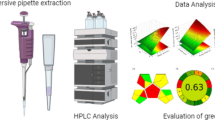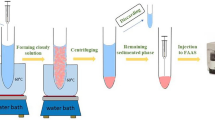Abstract
A fast and efficient dispersive liquid-liquid microextraction (DLLME) method was developed for extraction of phenolic compounds from red, rose, or white wine followed by HPLC determination in this study. After different extraction solvents and conditions were evaluated, the fastest and highest efficiency extraction of 12 phenolic compounds including gallic acid, protocatechuic acid, chlorogenic acid, catechin, vanillic acid, caffeic acid, syringic acid, epicatechin, p-coumaric acid, trans-ferulic acid, quercetin, and kaempferol was achieved by using 1000 μL of ethyl acetate as an extraction solvent and 500 μL of acetonitrile as a dispersive solvent. The mixtures of solvents were mixed with 1000 μL of wine sample for 10 s of extraction time. The extractions were carried out two times. Under the optimal condition, the extraction recoveries of 12 phenolic compounds were in a range from 76.56 to 137.74%. Meanwhile, the linearity, sensitivity, and precision of an optimized HPLC analysis method were evaluated. The results showed that each phenolic compound had a good regression coefficient (R 2). The limits of detections and quantifications for all the 12 compounds were at 0.001 to 0.133 and 0.004 to 0.433 mg/L, respectively. The relative standard deviations of intra- and inter-day determinations of the 12 compounds were below 6.58 and 4.11%, respectively. The results showed that the red wines had the highest concentration of total phenolic compounds (48.74–196.07 mg/L), followed by the rose wine (31.11 mg/L) and white wine (11.18–30.39 mg/L). Catechin was the dominant phenolic in all the wines (exception of wine sample W8) and ranged from 3.02 to 72.89 mg/L. In general, the developed dispersive liquid-liquid microextraction with HPLC analysis is a fast and efficient method to determine the phenolic compounds in wine.







Similar content being viewed by others
References
Barcia MT, Pertuzatti PB, Rodrigues D, Gómez-Alonso S, Hermosín-Gutiérrez I, Godoy HT (2014) Occurrence of low molecular weight phenolics in Vitis vinifera, red grape cultivars and their winemaking by-products from São Paulo (Brazil). Food Res Int 62:500–513
Barrio-Galán RD, Medel-Marabolí M, Peña-Neira Á (2015) Effect of different aging techniques on the polysaccharide and phenolic composition and sensory characteristics of Syrah red wines fermented using different yeast strains. Food Chem 179:116–126
Biparva P, Ehsani M, Hadjmohammadi MR (2012) Dispersive liquid-liquid microextraction using extraction solvents lighter than water combined with high performance liquid chromatography for determination of synthetic antioxidants in fruit juice samples. J Food Compos Anal 27:87–94
Burin VM, Arcari SG, Costa LLF, Bordignonluiz AMT (2011) Determination of some phenolic compounds in red wine by RP-HPLC: method development and validation. J Chromatogr Sci 49:647–651
Campillo N, Viñas P, Férez-Melgarejo G, Hernández-Córdoba M (2013) Liquid chromatography with diode array detection and tandem mass spectrometry for the determination of neonicotinoid insecticides in honey samples using dispersive liquid-liquid microextraction. J Agr Food Chem 61:4799–4805
Campone L, Piccinelli AL, Pagano I, Carabetta S, Sanzo RD, Russo M, Rastrelli L (2014) Determination of phenolic compounds in honey using dispersive liquid-liquid microextraction. J Chromatogr A 1334:9–15
Chen B, Wu FQ, Wu WD, ** BH, **e LQ, Feng W, Ouyang GF (2016) Determination of 27 pesticides in wine by dispersive liquid-liquid microextraction and gas chromatography-mass spectrometry. Microchem J 126:415–422
Chu SP, Tseng WC, Kong PH, Huang CK, Chen JH, Chen PS, Huang SD (2015) Up-and-down-shaker-assisted dispersive liquid-liquid microextraction coupled with gas chromatography-mass spectrometry for the determination of fungicides in wine. Food Chem 185:377–382
de Quirós ARB, Lage-Yusty MA, López-Hernández J (2009) HPLC-analysis of polyphenolic compounds in Spanish white wines and determination of their antioxidant activity by radical scavenging assay. Food Res Int 42:1018–1022
Espitia-lópez J, Escalona-buendía HB, Luna H, Verde-calvo JR (2015) Multivariate study of the evolution of phenolic composition and sensory profile on mouth of Mexican red merlot wine aged in barrels vs wood chips. Cyta-J Food 13:26–31
Fanzone M, Zamora F, Jofré V, Assof M, Gómez-Cordovés C, Peña-Neira Á (2012) Phenolic characterisation of red wines from different grape varieties cultivated in Mendoza province (Argentina). J Sci Food Agr 92:704–718
Fernández-Solà J (2015) Cardiovascular risks and benefits of moderate and heavy alcohol consumption. Nat Rev Cardiol 12:576–587
Gao Y, Tian Y, Liu D, Li Z, Zhang XX, Li JM, Huang JH, Wang J, Pan QH (2015) Evolution of phenolic compounds and sensory in bottled red wines and their co-development. Food Chem 172:565–574
Ginjom I, D’Arcy B, Caffin N, Gidley M (2011) Phenolic compound profiles in selected Queensland red wines at all stages of the wine-making process. Food Chem 125:823–834
Gonzalo-Diago A, Dizy M, Fernández-Zurbano P (2014) Contribution of low molecular weight phenols to bitter taste and mouthfeel properties in red wines. Food Chem 154:187–198
Gure A, Lara FJ, García-Campaña AM, Megersa N, Olmo-Iruela MD (2015) Vortex-assisted ionic liquid dispersive liquid-liquid microextraction for the determination of sulfonylurea herbicides in wine samples by capillary high-performance liquid chromatography. Food Chem 170:348–353
Han FL, Li Z, Xu Y (2015) Contribution of monomeric anthocyanins to the color of young red wine: statistical and experimental approaches. J Food Sci 80:C2751–C2758
Helm L, Macdonald IA (2015) Impact of beverage intake on metabolic and cardiovascular health. Nutr Rev 73:120–129
Huang Y, Lu WW, Chen B, Wu M, Li SG (2014) Determination of 13 phenolic compounds in rice wine by high-performance liquid chromatography. Food Anal Method 8:825–832
Ivanova-Petropulos V, Hermosín-Gutiérrez I, Boros B, Stefova M, Stafilov T, Vojnoski B, Dörnyei Á, Kilár F (2015) Phenolic compounds and antioxidant activity of Macedonian red wines. J Food Compos Anal 41:1–14
Lai XW, Ruan CQ, Liu RC, Liu CG (2014) Application of ionic liquid-based dispersive liquid-liquid microextraction for the analysis of ochratoxin a in rice wines. Food Chem 161:317–322
Lampíř L (2013) Varietal differentiation of white wines on the basis of phenolic compounds profile. Czech J Food Sci 31:172–179
Leeuw RV, Kevers C, Pincemail J, Defraigne JO, Dommes J (2014) Antioxidant capacity and phenolic composition of red wines from various grape varieties: specificity of pinot noir. J Food Compos Anal 36:40–50
Li J, Jia SD, Yoon SJ, Lee SJ, Kwon SW, Lee J (2016) Ion-pair dispersive liquid-liquid microextraction solidification of floating organic droplets method for the rapid and sensitive detection of phenolic acids in wine samples using liquid chromatography combined with a core-shell particle column. J Food Compos Anal 45:73–79
Li Z, Pan QH, ** ZM, Mu L, Duan CQ (2011) Comparison on phenolic compounds in Vitis vinifera cv. Cabernet sauvignon wines from five wine-growing regions in China. Food Chem 125:77–83
Lorrain B, Ky I, Pechamat L, Teissedre PL (2013) Evolution of analysis of polyphenols from grapes, wines, and extracts. Molecules 18:1076–1100
Maciel JV, Soares BM, Mandlate JS, Picoloto RS, Bizzi CA, Flores EMM, Duarte FA (2014) Simple and fast method for iron determination in white and red wines using dispersive liquid-liquid microextraction and ultraviolet-visible spectrophotometry. J Agr Food Chem 62:8340–8345
Malovaná S, Montelongo FJG, Pérez JP, Rodríguez-Delgado MA (2001) Optimisation of sample preparation for the determination of trans-resveratrol and other polyphenolic compounds in wines by high performance liquid chromatography. Anal Chim Acta 428:245–253
Medić-Sarić M, Rastija V, Bojić M (2011) Recent advances in the application of high performance liquid chromatography in the analysis of polyphenols in wine and propolis. J AOAC Int 94:32–42
Nave F, Cabrita MJ, da Costa CT (2007) Use of solid-supported liquid-liquid extraction in the analysis of polyphenols in wine. J Chromatogr A 1169:23–30
Oliveira CM, Barros AS, Ferreira ACS, Silva AMS (2015) Influence of the temperature and oxygen exposure in red port wine: a kinetic approach. Food Res Int 75:337–347
Pati S, Crupi P, Benucci I, Antonacci D, Luccia AD, Esti M (2014) HPLC-DAD-MS/MS characterization of phenolic compounds in white wine stored without added sulfite. Food Res Int 66:207–215
Pereira V, Câmara JS, Cacho J, Marques JC (2010) HPLC-DAD methodology for the quantification of organic acids, furans and polyphenols by direct injection of wine samples. J Sep Sci 33:1204–1215
Pérez-Magariño S, Ortega-Heras M, Cano-Mozo E (2008) Optimization of a solid-phase extraction method using copolymer sorbents for isolation of phenolic compounds in red wines and quantification by HPLC. J Agr Food Chem 56:11560–11570
Porgalı E, Büyüktuncel E (2012) Determination of phenolic composition and antioxidant capacity of native red wines by high performance liquid chromatography and spectrophotometric methods. Food Res Int 45:145–154
Pyrzynska K, Sentkowska A (2015) Recent developments in the HPLC separation of phenolic food compounds. Crit Rev Anal Chem 45:41–51
Rezaee M, Assadi Y, Hosseini MRM, Aghaee E, Ahmadi F, Berijani S (2006) Determination of organic compounds in water using dispersive liquid-liquid microextraction. J Chromatogr A 1116:1–9
Ružić I, Škerget M, Knez Ž, Runje M (2011) Phenolic content and antioxidant potential of macerated white wines. Eur Food Res Technol 233:465–472
Saraji M, Boroujeni MK (2014) Recent developments in dispersive liquid-liquid microextraction. Anal Bioanal Chem 406:2027–2066
Šeruga M, Novak I, Jakobek L (2011) Determination of polyphenols content and antioxidant activity of some red wines by differential pulse voltammetry, HPLC and spectrophotometric methods. Food Chem 124:1208–1216
Silva CL, Pereira J, Wouter VG, Giró C, Câmara JS (2011) A fast method using a new hydrophilic-lipophilic balanced sorbent in combination with ultra-high performance liquid chromatography for quantification of significant bioactive metabolites in wines. Talanta 86:82–90
Tauchen J, Marsik P, Kvasnicova M, Maghradze D, Kokoska L, Vanek T, Landa P (2015) In vitro antioxidant activity and phenolic composition of Georgian, central and west European wines. J Food Compos Anal 41:113–121
Tseng WC, Chu SP, Kong PH, Huang CK, Chen JH, Chen PS, Huang SD (2014) Water with low concentration of surfactant in dispersed solvent-assisted emulsion dispersive liquid-liquid microextraction for the determination of fungicides in wine. J Agr Food Chem 62:9059–9065
Tuzen M, Pekiner OZ (2015) Ultrasound-assisted ionic liquid dispersive liquid-liquid microextraction combined with graphite furnace atomic absorption spectrometric for selenium speciation in foods and beverages. Food Chem 188:619–624
Wang SL, Liu CY, Yang SP, Liu FM (2013) Ionic liquid-based dispersive liquid-liquid microextraction following high-performance liquid chromatography for the determination of fungicides in fruit juices. Food Anal Method 6:481–487
Wu QH, Wu CX, Wang C, Lu XN, Li XM, Wang Z (2011) Sensitive determination of cadmium in water, beverage and cereal samples by a novel liquid-phase microextraction coupled with flame atomic absorption spectrometry. Anal Methods-Uk 3:210–216
Zhou LZ, Yang ZG, Liu YC, Yang Y, Qiu B (2015) Determination of mono-terpenols in wine by dispersive liquid-liquid micro-extraction coupled with gas chromatography-mass spectrometry. Chinese J Anal Chem 43:534–539
Author information
Authors and Affiliations
Corresponding author
Ethics declarations
Funding
This study was supported by the National Natural Science Foundation of China (Grant No. 31401479), National Key Research Program of China (Grant No. 2016YFD0400504), Science and Technology Innovative Program of Shaanxi Province (Grant No. 2015NY131), and Scientific Research Project of Northwest A&F University (Grant Nos. Z109021202 and Z109021103).
Conflict of Interest
** Yang declares that he has no conflict of interest. Huiqing Li declares that he has no conflict of interest. Hua Wang declares that he has no conflict of interest. Fuliang Han declares that he has no conflict of interest. Shuying **g declares that he has no conflict of interest. Chunlong Yuan declares that he has no conflict of interest. Anque Guo declares that he has no conflict of interest. Yulin Zhang declares that he has no conflict of interest. Zhimin Xu declares that he has no conflict of interest.
Ethical Approval
This article does not contain any studies involved with human participants or animals.
Informed Consent
Not applicable.
Additional information
** Yang and Huiqing Li contributed equally to this work.
Rights and permissions
About this article
Cite this article
Yang, P., Li, H., Wang, H. et al. Dispersive Liquid-Liquid Microextraction Method for HPLC Determination of Phenolic Compounds in Wine. Food Anal. Methods 10, 2383–2397 (2017). https://doi.org/10.1007/s12161-016-0781-2
Received:
Accepted:
Published:
Issue Date:
DOI: https://doi.org/10.1007/s12161-016-0781-2




